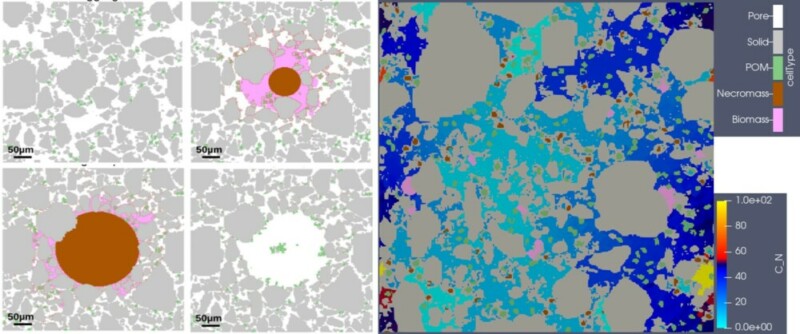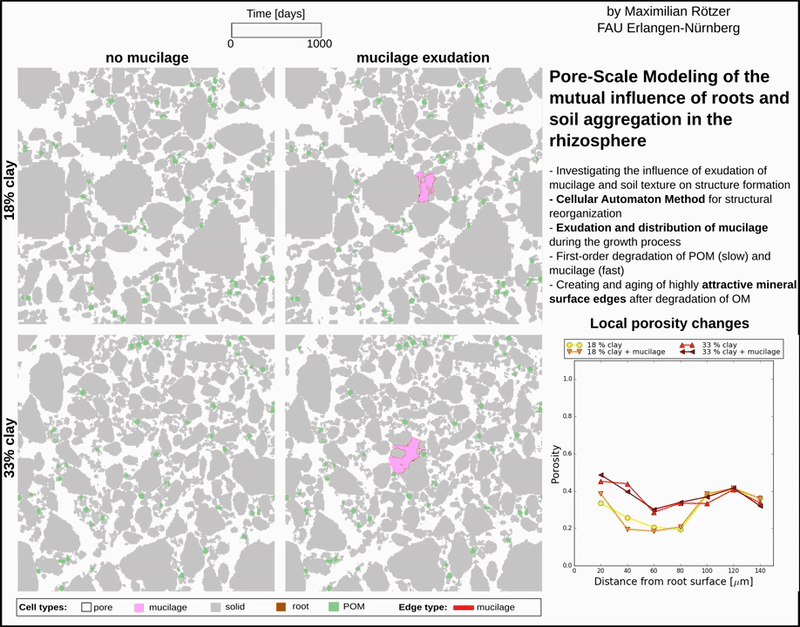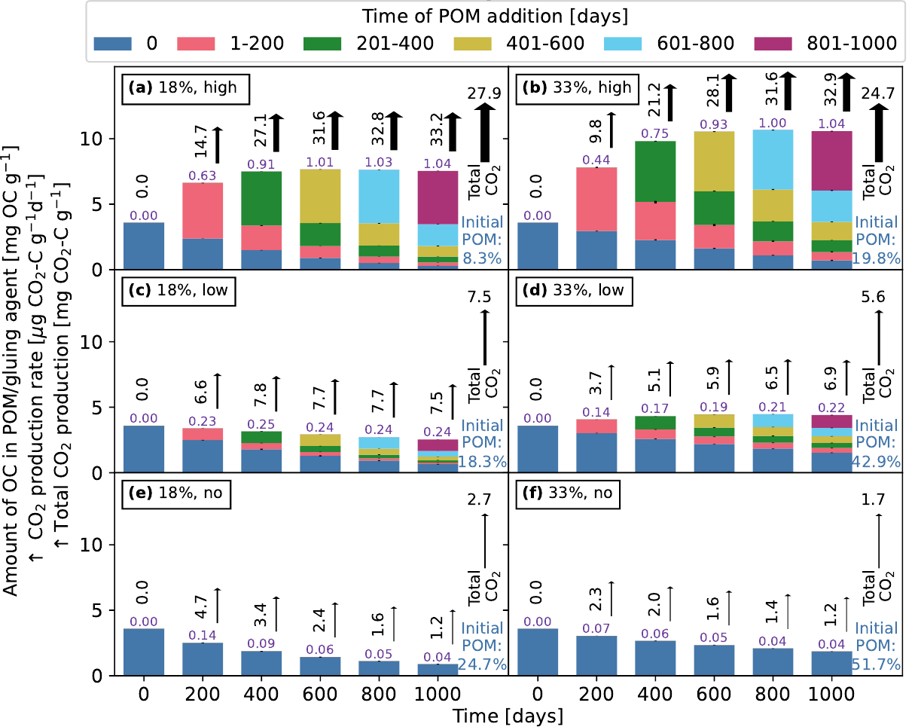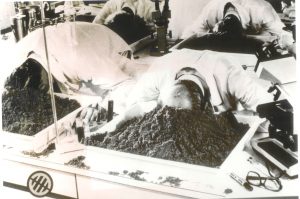Research
Projects Reviewer Duties Publications Supervised Theses Conference Talks
See also my Research Profiles at Google Scholar and ResearchGate
Research Interests
Mathematics in the geosciences, in particular structure evolution in soils, modelling and simulation of reactive contaminant transport in porous media, evaluation of natural attenuation, geostatistics, efficient and accurate solution of hydrogeochemical multicomponent models.
Mathematics in biology, in particular spatio-temporal differential equation models of regulatory networks

Some current research highlights in the framework of the DFG Research Unit 2179 MAD Soil (“Microaggregates: Formation and turnover of the structural building blocks of soils”) and the DFG Priority Program 2089 (Rhizosphere Spatiotemporal Organisation – a Key to Rhizosphere Functions”:
In the last decade my research focussed on advancing our understanding of structure formation in soils on the microscale, and the coupled carbon turnover. In order to study the self-organization of soil aggregates (particles of diameters less than 250 microns) by various attracting forces influenced by geochemistry, and microbiology, a novel, comprehensive mathematical model has been developed that explicitly represents the pore structure derived from CT scans. To take into account specific properties of the rhizosphere the functional range of existing models for aggregation or carbon turnover had to be extended and, e.g. an explicit phase of mucilage, root dynamics or C/N specific microbial growth included.
Due to its high complexity, we need to use upscaling techniques to incorporate information from the micro to the macroscale. We use combinations of Discontinuous Galerkin Methods and Cellular Automata as numerical approximations of the derived mechanistic model and integrate them in an efficient software tool using massively parallel architecture.

Below you see information gained in Zech et al. (2022) elucidating the impact of soil texture, POM input and degradation rates on carbon turnover and CO2 production by microbes.

Subsequently you find information on projects I participated or lead (Volume of third-party funding as PI/Co-PI since 2015 approx. 1.176 M. Euro (2021)), publications, my review activities, supervised bachelor, master and diploma theses, and a list of talks at conferences.
Projects
Funding source: DFG / Schwerpunktprogramm (SPP)
Project leader: ,
To couple three interwoven areas of rhizosphere research “Processes, Methods and Applications”, we utilize and improve mechanistic, mathematical models in forms of combined cellular automata and PDE/ODE systems on the microscale, offering the opportunity to bridge scales by homogenization techniques. The
systematic study of the interaction of transformation processes in the rhizosphere focussing on mucilage and root hairs, and its couplings to soil structure, geochemistry, microbiology, and…
Funding source: DFG-Einzelförderung / Sachbeihilfe (EIN-SBH)
Project leader: ,
Funding source: DFG / Schwerpunktprogramm (SPP)
Project leader: ,
The self-organization of the aggregates in the rhizosphere by various
attracting forces influenced by geochemistry, and microbiology shall
be studied by a novel, comprehensive model. This model should
account for processes on the microscale (single roots, pore scale),
and then be upscaled to the root system scale (macroscale) by
mathematical homogenization. This goal exceeds the functional range
of existing models for aggregation and needs the introduction of an
explicit…
Funding source: Deutsche Forschungsgemeinschaft (DFG)
Project leader: ,
Funding source: Deutscher Akademischer Austauschdienst (DAAD)
Project leader:
Nonlinear (multiphase) flow and reactive multicomponent transport problems in highly heterogeneous porous media and their numerical simulation are of great interest for evaluating site remediation, energy exploitation or CO2 sequestration scenarios. The resulting advection-diffusion-reaction-systems are coupled nonlinear parabolic partial differential equations, and we have parabolic or elliptic nonlinear flow equations, possibly degenerate. The development of convergent and efficient numerical s…
Funding source: Bundesministerium für Forschung, Technologie und Raumfahrt (BMFTR)
Project leader:
The project was a cooperation of a group of applied mathematicians with the Russian company Aeroservice for the development and optimization of new photocatalytic filter systems for air cleaning of nanoparticles and organic substances with the help of mathematical simulation tools. For the simulation of aerosol transport in the filter made of polypropylene fibers, which is used in hospitals or airports, e.g., mathematical models and efficient solution algorithms had to be developed. These allow on…
Funding source: DFG-Einzelförderung / Sachbeihilfe (EIN-SBH)
Project leader:
Soil colloids may influence the interaction between solutes and the immobile solid phase. A coupling to the fluid transport is possible by processes of sedimentation, flocculation, precipitation, filtration and deposition. The objective of this research project is the qualitative and quantitative examination of the crucial aspects of colloidal-influenced solute- and fluid transport by means of systematic, prognostic simulation. In detail,
- the attachment and detachment of colloids…
Funding source: BMBF / Verbundprojekt
Project leader: ,
The evaluation of the potential of contaminated sites concerning natural attenuation needs comprehensive process descriptions and accurate, reliable numerical algorithms. Numerical errors may lead to qualitatively completely wrong conclusions concerning the potential of the site for degradation. It has been developed a comprehensive and flexible simulation tool, that is outstanding concerning the variety of processes, the quality and efficiency of the calculations ensured by modern numerical methods…
Funding source: Bayerisches Staatsministerium für Umwelt und Gesundheit (StMUG) (bis 09/2013)
Project leader: ,
The project included the mathematical modelling of natural attenuation processes in the subsurface and the extension of a software tool for complex reactive multicomponent processes in the framework of mixed hybrid and conforming finite elements. New parameter identification methods allow the parametrization of unknown functions or a formfree optimization, and help to overcome the dilemma of missing data in complex models. Work included instationary 3D simulations and scenarios of contaminated s…
Funding source: Bundesministerium für Forschung, Technologie und Raumfahrt (BMFTR)
Project leader:
Mathematical simulation tools allow the quantitative integration of competing transport and transformation processes which are relevant for a seepage water risk prognosis. Therefore model simulations have to contain a comprehensive process description, while they can serve for parameter identification by inverse modelling of suitable column or batch experiments, and allow to quantify the dependence of a key variable on parameters through a simultaneous sensitivity analysis. The software platform…
Publications
- , , , , , , , , :
Correlating pore space morphology with numerically computed soil gas diffusion for structured loam and sand, including stochastic 3D microstructure modeling
In: Scientific Reports 15 (2025), Article No.: 20174
ISSN: 2045-2322
DOI: 10.1038/s41598-025-05825-0
BibTeX: Download
- , , :
Coupling scales in process-based soil organic carbon modeling including dynamic aggregation
In: Journal of Plant Nutrition and Soil Science (2024)
ISSN: 1436-8730
DOI: 10.1002/jpln.202300080
BibTeX: Download
- , , , , , , , , , , , , , , , , , , , , , :
Architecture of soil microaggregates: Advanced methodologies to explore properties and functions
In: Journal of Plant Nutrition and Soil Science (2023)
ISSN: 1436-8730
DOI: 10.1002/jpln.202300149
BibTeX: Download - , , , , , , , :
Quantifying the Impact of 3D Pore Space Morphology on Soil Gas Diffusion in Loam and Sand
In: Transport in Porous Media (2023)
ISSN: 0169-3913
DOI: 10.1007/s11242-023-01971-z
BibTeX: Download - , , , , , , , :
Quantifying the Impact of 3D Pore Space Morphology on Soil Gas Diffusion in Loam and Sand
In: Transport in Porous Media (2023)
ISSN: 0169-3913
DOI: 10.1007/s11242-023-01971-z
BibTeX: Download - , , :
Pore scale modeling of the mutual influence of roots and soil aggregation in the rhizosphere
In: Frontiers in Soil Science 3 (2023), Article No.: 1155889
ISSN: 2673-8619
DOI: 10.3389/fsoil.2023.1155889
BibTeX: Download
- , , , , , , , , , , , , , , , , , , , , , , , , :
Linking rhizosphere processes across scales: Opinion
In: Plant and Soil (2022)
ISSN: 0032-079X
DOI: 10.1007/s11104-022-05306-7
URL: https://link.springer.com/article/10.1007/s11104-022-05306-7
BibTeX: Download - , , , , :
How water connectivity and substrate supply shape the turnover of organic matter – Insights from simulations at the scale of microaggregates
In: Geoderma 405 (2022), Article No.: 115394
ISSN: 0016-7061
DOI: 10.1016/j.geoderma.2021.115394
BibTeX: Download - , , , , , :
Explicit spatial modeling at the pore scale unravels the interplay of soil organic carbon storage and structure dynamics
In: Global Change Biology (2022)
ISSN: 1354-1013
DOI: 10.1111/gcb.16230
BibTeX: Download
- , , , :
Global random walk solvers for fully coupled flow and transport in saturated/unsaturated porous media
In: Advances in Water Resources 152 (2021), Article No.: 103935
ISSN: 0309-1708
DOI: 10.1016/j.advwatres.2021.103935
BibTeX: Download
- , , , , , , , :
Numerical benchmark study for flow in highly heterogeneous aquifers
In: Advances in Water Resources (2020), p. 103558
ISSN: 0309-1708
DOI: 10.1016/j.advwatres.2020.103558
BibTeX: Download - , , , , :
Microaggregation of goethite and illite evaluated by mechanistic modeling
In: Applied Clay Science 198 (2020), Article No.: 105845
ISSN: 0169-1317
DOI: 10.1016/j.clay.2020.105845
BibTeX: Download
- , , , , , , :
Application of a cellular automaton method to model the structure formation in soils under saturated conditions: A mechanistic approach
In: Frontiers in Environmental Science 7 (2019)
ISSN: 2296-665X
DOI: 10.3389/fenvs.2019.00170
URL: https://www.frontiersin.org/articles/10.3389/fenvs.2019.00170/abstract
BibTeX: Download
- , , , , , :
Groundwater data improve modelling of headwater stream CO2 outgassing with a stable DIC isotope approach
In: Biogeosciences 15 (2018), p. 3093-3106
ISSN: 1726-4170
DOI: 10.5194/bg-15-3093-2018
URL: https://www.biogeosciences.net/15/3093/2018/
BibTeX: Download - , , , :
Discrete-Continuum Multiphase Model for Structure Formation in Soils Including Electrostatic Effects
In: Frontiers in Environmental Science 6 (2018), Article No.: 96
ISSN: 2296-665X
DOI: 10.3389/fenvs.2018.00096
BibTeX: Download - , , , , , , , , , , , :
Microaggregates in Soils
In: Journal of Plant Nutrition and Soil Science 181 (2018), p. 104-136
ISSN: 1436-8730
DOI: 10.1002/jpln.201600451
URL: http://onlinelibrary.wiley.com/doi/10.1002/jpln.201600451/full
BibTeX: Download
- , , :
Discrete-continuum multiscale model for transport, biomass development and solid restructuring in porous media
In: Advances in Water Resources 107 (2017), p. 393-404
ISSN: 0309-1708
DOI: 10.1016/j.advwatres.2017.04.001
BibTeX: Download
- , , , , :
A coupled finite element-global random walk approach to advection-dominated transport in porous media with random hydraulic conductivity
In: Journal of Computational and Applied Mathematics 246 (2013), p. 27-37
ISSN: 0377-0427
DOI: 10.1016/j.cam.2012.06.027
URL: https://www1.am.uni-erlangen.de/research/publications/Jahr_2013/2013_SuciuRaduPrechtelBrunnerKn_ACoupledFiniteElementGlobalRandomWalkApproach
BibTeX: Download
- , , , , , :
Entwicklung, Zuverlässigkeit und Effizienz reaktiver Mehrkomponententransportmodelle
In: KORA - Synopse "Systemanalyse, Modellierung und Prognose der Wirkungen natürlicher Schadstoffminderungsprozesse - eine rezente Synopse", 2008, p. 195-233 (Gemeinsame Mitteilungen des Dresdner Grundwasserforschungszentrum e.V. und seiner Partner, Vol.5)
BibTeX: Download - , , , , , :
Grundlagen der Systemanalyse, Modellierung und Prognose
In: KORA - Synopse "Systemanalyse, Modellierung und Prognose der Wirkungen natürlicher Schadstoffminderungsprozesse - eine rezente Synopse", 2008, p. 1-81 (Gemeinsame Mitteilungen des Dresdner Grundwasserforschungszentrum e.V. und seiner Partner, Vol.5)
URL: https://www1.am.uni-erlangen.de/research/publications/Jahr_2008/2008_LucknerSommerLucknerBilekKnPrechtel_GrundlagenDerSystemanalyseModellierungUndPrognose
BibTeX: Download - , , , :
A Mixed Hybrid Finite Element Discretization Scheme for Reactive Transport in Porous Media
In: Kunisch K., Of G., Steinbach O. (ed.): Numerical Mathematics and Advanced Applications, Berlin, Heidelberg: 2008
BibTeX: Download
- , , , :
Natural Attenuation: hohe Anforderungen an die Modellsimulation Teilprojekt 6 des BayFoNA: Modellierung
In: Grundwasser 11 (2006), p. 217-225
ISSN: 1430-483X
DOI: 10.1007/s00767-006-0147-6
URL: https://www1.am.uni-erlangen.de/research/publications/Jahr_2006/2006_PrechtelBitterlichRaduKn_NaturalAttenuationHoheAnforderAnModellSimulation
BibTeX: Download - , , , :
Reaktive Mehrkomponentenprobleme: Sicherung von Effizienz und Zuverlässigkeit
In: Modellierung und Prognose von Natural Attenuation-Prozessen im Untergrund, Dresden: , 2006, p. 75-90 (Gemeinsame Mitteilungen des Dresdner Grundwasserforschungszentrum e.V. und seiner Partner, Vol.3)
URL: https://www1.am.uni-erlangen.de/research/publications/Jahr_2006/2006_PrechtelHoffmannKraeutleKn_ReaktiveMehrKomponentenProblemeEffizienzUndZuverlaessigkeit
BibTeX: Download
- , , , :
Modellierung des reaktiven Transports von Schadstoffen in der (un-)gesättigten Bodenzone zur Prognose der natürlichen Selbstreinigung - Komplexe Probleme berechenbar machen
In: Dechema (ed.): Statusseminar Forschungsverbund KORA - Kontrollierter natürlicher Rückhalt und Abbau von Schadstoffen bei der Sanierung kontaminierter Grundwässer und Böden, Frankfurt a. M.: , 2005, p. 417-427
ISBN: 389746071X
URL: https://www1.am.uni-erlangen.de/research/publications/Jahr_2005/2005_KnKraeutleOssmannPrechtel_Proj73ModellDesReaktTranspVonSchadstInDer(un)gesättBodenzonePrognSelbstreinig
BibTeX: Download - , , , , :
ParRichy: Parallel Simulation of Bioreactive Multicomponent Transport Processes in Porous Media
In: Arndt Bode, Franz Durst (ed.): High Performance Computing in Science and Engineering, Garching 2004, Berlin, Heidelberg: Springer, 2005, p. 181-192
ISBN: 978-3-540-26145-2
DOI: 10.1007/3-540-28555-5_16
URL: https://www1.am.uni-erlangen.de/research/publications/Jahr_2005/2005_KraeutleBausePrechtelRaduKn_ParRichyParallSimulOfBioreactMulticompTrnsptProcessInPM
BibTeX: Download - :
Modelling and Efficient Numerical Solution of Hydrogeochemical Multicomponent Transport Problems by Process-Preserving Decoupling Techniques
Aachen: Shaker, 2005
ISBN: 3-8322-4295-3
BibTeX: Download
- , , :
Estimation of the total hydrocarbon concentration in the soil of a former petrochemical site: Methodological study
In: Oil & Gas Science and Technology-Revue De L Institut Francais Du Petrole 59 (2004), p. 275-295
ISSN: 1294-4475
DOI: 10.2516/ogst:2004020
BibTeX: Download
- , , , , :
Influence of Surfactants on Spreading of Contaminants and Soil Remediation
In: Willi Jäger, Hans-Joachim Krebs (ed.): Mathematics - Key Technology for the Future, Berlin, Heidelberg: Springer, 2003, p. 152-161
ISBN: 978-3-642-62914-3
DOI: 10.1007/978-3-642-55753-8_12
URL: https://www1.am.uni-erlangen.de/research/publications/Jahr_2003/2003_KnBitterlichTeranPrechtelSchneid_InfluOfSurfactOnSpreadOfContaminSoilRemed
BibTeX: Download
- , :
Accurate and efficient simulation of coupled water flow and nonlinear reactive transport in the saturated and vadose zone-application to surfactant enhanced and intrinsic bioremediation
In: S. Majid Hassanizadeh, Ruud J. Schotting, William G. Gray and George F. Pinder (ed.): Computational Methods in Water Resources, 2002, p. 687-694 (Computational Methods in Water Resources, Proceedings of the XIV International Conference on Computational Methods in Water Resources (CMWR XIV), Vol.47)
ISBN: 978-0-444-50975-8
DOI: 10.1016/S0167-5648(02)80125-3
URL: https://www1.am.uni-erlangen.de/research/publications/Jahr_2002/2002_PrechtelKn_AccurEfficSimuOfCouplWaterFlow+nonlinReactTransp
BibTeX: Download - , , , :
Simulation of carrier-facilitated transport of phenanthrene in a layered soil profile
In: Journal of Contaminant Hydrology 56 (2002), p. 209-225
ISSN: 0169-7722
DOI: 10.1016/S0169-7722(01)00211-X
URL: https://www1.am.uni-erlangen.de/research/publications/Jahr_2002/2002_PrechtelKnSchneidTotsche_SimulationOfCarrFaciTrnasportOfPhenanInALayerSoilProfile
BibTeX: Download
- , , :
A comprehensive tool for the simulation of complex reactive transport and flow in soils
In: Land Contamination and Reclamation 8 (2000), p. 357-365
ISSN: 0967-0513
URL: https://www1.am.uni-erlangen.de/research/publications/Jahr_2000/2000_SchneidPrechtelKn_AComperToolForTheSimulaOfComplexReactiveTransport
BibTeX: Download
- :
La pollution d'un site par des hydrocarbures - aspects de la modélisation hydrogéologique et étude géostatistique (Diploma thesis, 1998)
BibTeX: Download
- :
Die Schätzung von Variogrammen durch Betrachtung ihrer Integrale (Diploma thesis, 1997)
BibTeX: Download
Reviews
Reviewer for the Agence Nationale de Recherche in France and the DFG (German Research Foundation),
and the following journals: BioSystems, Computer Methods in Applied Mechanics and Engineering, Environmental Pollution, Environmental Science & Technology, Geoderma, International Journal for Numerical Methods in Fluids, International Journal on Geomathematics, Mathematics and Computers in Simulation, Nonlinear Analysis: Real World Applications, Plant and Soil, PLOS One, and Water Resources Research.
Theses that I have supported / supervised / evaluated:
Diploma theses:
Kastner, Stephan: “Mathematische Modellierung und numerische Simulation von Selbstreinigungsprozessen” February 2002
Oßmann, Stephan: “Mathematische Modellierung und numerische Simulation von präferenziellem Fließen mit Stofftransport in strukturierten porösen Medien“, June 2004
Schumann, Robert: “Operator Splitting und voll gekoppelte Lösungsalgorithmen für Transport-Reaktionssysteme in porösen Medien“, May 2006
Frank, Florian: “Hydrogeochemical multi-component transport – mineral dissolution and precipitation with consideration of porosity changes in variably-saturated porous media“, 2008
Bachelor theses:
Hutter, Jana: “Die Adsorptions-Advektions-Dispersionsgleichung“, 2009 (Technomathematik)
Rupp, Andreas: “Numerische Studien zur Strukturbildung in Böden durch Mineralreaktionen“, 2014 (Mathematics)
Clarner, Jan-Patrick: “Modellierung und Simulation der Bildung und Transformation von Aggregaten in Böden“, 2016 (Mathematics)
Conrad, Marcus: “Integration von Reaktionstermen in das 1D-Flachwassermodell basierend auf dem Discontinuous-Galerkin-Verfahren“, 2016 (Integrated Life Sciences)
Klingberg, Tim: “Charakterisierung des stationären Eingangs-/Ausgangsverhaltens von Doppelphosphorylierungszyklen“, 2017 (Integrated Life Sciences)
Pindl, Kathrin: “Charakterisierung des Eingangs-/Ausgangsverhaltens der MAP Kinase Kaskade“, 2017 (Integrated Life Sciences)
Möckel, Marianna: “Einfluss der Autoregulation auf das dynamische Verhalten von Zwei-Komponenten Systemen“, 2017 (Integrated Life Sciences)
Eckstein, Nadja: “Charakterisierung der dynamischen Regulation von SCF Ligasen durch CAND1“, 2017 (Integrated Life Sciences)
Hermann, Anne: “The influence of a symmetric boundary condition on the effective diffusion tensor of a soil column calculated by homogenisation“, 2022 (Mathematics)
Heimann, Lennard: “Untersuchungen zu Metabolismus und Genregulation in Corynebacterium diphteriae“, 2023 (Integrated Life Sciences)
Master theses:
Hutter, Jana: “Spatio-temporal modelling of cell cycle control“, 2011 (Technomathematik)
Pérez Pardo, Beatriz: “Mathematical modeling and simulation of a microfluidic reactor. From real application towards a 2D computer simulation“, August 2012 (Computational Engineering)
Eckstein, Nadja: “Mathematical Modelling and Simulation of the Influence of Extracellular Polymeric Substances on Microaggregate Formation in Soils“, November 2018 (Integrated Life Sciences)
Tapia Schulze, Lorenzo: “Mathematical Modeling and Simulation of the chemotactic movement of neutrophils in inflammatory environments“, September 2022 (Computational and Applied Mathematics)
Talks:
- “A Comprehensive Tool for the Simulation of Complex Reactive Transport and Flow in Soils”.
XXV General Assembly of the European Geophysical Society (EGS), April 25-29, 2000, Nice, France. - “Accurate and Efficient Simulation of Coupled Water Flow and Nonlinear Reactive Transport in the Saturated and Vadose Zone – Application to Surfactant Enhanced and Intrinsic Bioremediation”.
Computational Methods in Water Resources XIV, June 23-28, 2002, Delft, The Netherlands. - “Entwicklung einer Simulationssoftware zur Prognose von Schadstoffausbreitung und -abbau in der (un-)gesättigten Bodenzone”.
Workshop Forschungsverbundvorhaben “Nachhaltige Altlastenbewältigung unter Einbeziehung des natürlichen Reinigungsvermögens”, July 18-19, 2002, Freising, Germany. - Talks on “Mikrobiologie”, “Hydrochemie” and “Modellierung”.
Workshop Forschungsverbundvorhaben “Nachhaltige Altlastenbewältigung unter Einbeziehung des natürlichen Reinigungsvermögens”, February 20-21, 2003, Freising, Germany. - “Modelling and numerical simulation of variably saturated flow and coupled reactive, biogeochemical transport”.
Workshop on Modeling and Simulation in Chemical Engineering, June 30 – July 4, 2003, Coimbra, Portugal. - “Abbaukinetiken: Möglichkeiten der Modellierung und Simulation”.
BMBF-Förderschwerpunkt KORA (Kontrollierter natürlicher Rückhalt und Abbau von Schadstoffen bei der Sanierung kontaminierter Grundwässer und Böden), Fachgespräch Mikrobiologie, September 18-19, 2003, Karlsruhe, Germany. - “Handlungsempfehlung: Schwerpunkt Modellierung”.
Symposium Natürliches Reinigungsvermögen – Natural Attenuation, Landesamt für Umweltschutz, November 10-11, 2003, Augsburg, Germany. - “Modeling and Simulation of Reactive Multicomponent Transport: Model Equations and Efficient Solution Concepts”.
Workshop Porous Media, Zentrum für Angewandte Geowissenschaften, December 2-3, 2004, Blaubeuren, Germany. - “Efficient Modified Newton’s Method for Solving Reactive Multicomponent Transport Problems in Porous Media”.
SIAM Conference on Mathematical and Computational Issues in the Geosciences, June 6-10, 2005, Avignon, France. - “Grundlagen und Modellierung der Schadstoffausbreitung im Boden”.
DECHEMA-Arbeitskreis “Auswirkungen von Stoff- und Energiefreisetzungen”, November 3, 2005, Frankfurt am Main, Germany. - “Große Mehrkomponentenprobleme berechenbar machen: Reduktion der Komplexität”.
2. BMBF Statusseminar KORA, November 22-23, 2005, Frankfurt am Main, Germany. - “Grundlagen und Stolpersteine der Modellierung in der Altlastenbearbeitung”.
BEW-Seminar “Numerische Modelle als Instrument in der Altlastenbearbeitung”, 31. Mai 2006, Duisburg, Germany - “Efficient process-preserving modified Newton’s method for solving reactive multicomponent transport problems in porous media”.
Workshop on simulation, modelling and numerical analysis, September 18-20, 2006, Liberec, Czech Republic. - “Efficient process-preserving and adaptive modified Newton’s method for solving reactive multicomponent transport problems in porous media”.
6th International Congress on Industrial and Applied Mathematics, July 16-20, 2007, Zurich, Switzerland. - “Modellierung als Werkzeug zur Prozessidentifikation und -quantifizierung von NA-Prozessen sprengstofftypischer Verbindungen”.
Abschließendes BMBF-Statusseminar des TV5 “Rüstungsaltlasten” – KORA, 17.-18. Juni 2008, Berlin, Germany. - “An adaptive, process-preserving modified Newton’s method to solve reactive multicomponent transport problems efficiently”.
5th European Congress on Computational Methods in Applied Sciences and Engineering (ECCOMAS), June 30 – July 5, 2008, Venice, Italy. - “Efficient and Reliable Simulation of Reactive Multicomponent Problems”.
Bio-Geo-Kolloquium Friedrich-Schiller-Universität Jena, December 16, 2008. - “Adaptive, Selective Coupling of Multicomponent Transport and Kinetic Reactions”.
SIAM Conference on Mathematical and Computational Issues in the Geosciences, June 15 – 18, 2009, Leipzig, Germany. - “Identification of biogeochemical degradation parameters of propylene glycol by complex modelling”.
Computational Methods in Water Resources XIX, June 17-21, 2012, Urbana-Champaign, Illinois, USA. - “Spatio-Temporal Modelling of Cell Cycle Control”.
SIAM Conference on the Life Sciences, August 7 – 10, 2012, San Diego, California, USA. - “Solving Coupled Reactive Multicomponent Problems in Geosciences and Biology”, May 30, 2013, University of Bergen, Norway.
- “Mechanistic Modeling of the Formation and Consolidation of Soil Microaggregates”, SIAM Conference on Mathematical and Computational Issues in the Geosciences, June 29 – July 2, 2015, Stanford, California, USA.
- “Process-based Modelling of the Formation and Consolidation of Soil Microaggregates”.
Computational Methods in Water Resources XXI, June 20-24, 2016, Toronto, Canada. - “Hybrid Discrete-Continuum Modeling for Transport, Biofilm Development and Solid Restructuring including Electrostatic Effects”.
General Assembly of the European Geophysical Union, April 23-28, 2017, Vienna, Austria. - “Mechanistic Model for Transport, Biofilm Development and Solid Restructuring in Soil Microaggregates”.
Workshop on Formation, Properties and Function of Soil Microaggregates, October 10-12, 2017, Munich. - “Linking Processes to Structure and Structure to Function: Hybrid Discrete-Continuum Modeling forMicroaggregate Formation”.
General Assembly of the European Geophysical Union, April 8-13, 2018, Vienna, Austria. - “Discrete-Continuum Multiscale Model for Evolving Microaggregates in Porous Media”.
PICO Presentation, General Assembly of the European Geophysical Union, April 8-13, 2018, Vienna, Austria. - “Hybrid cellular automata / PDE modeling for solid restructuring including EPS“, Computational Methods in Water Resources XXII, June 3-7, 2018, St. Malo, France.
- „Hybrid Cellular Automata / PDE Modeling for Self-organisation of Soil Microaggregate Structures“, SIAM Conference on Mathematical and Computational Issues in the Geosciences, March 11 – 14, 2019, Houston, Texas, USA.
-
“Microaggregation of goethite and illite: Linking mechanistic modeling and laboratory experiments”,
Online Presentation, General Assembly of the European Geophysical Union, May 4-8, 2020, Vienna, Austria.
-
„Evaluating the Interaction of Biofilms, Organic Matter and Soil Structures at the pore scale“,
Online Presentation, at 3rd ISMC Conf. on Advances in Modeling Soil Systems, May 18-21; and at InterPore 2021, 13th General Assembly, May 31- June 4, 2021.
- „Process-based, mechanistic modeling of dynamic structures at the pore scale“, Goldschmidt Conference, July 10-15, 2022, Honolulu, Hawaii, USA.
- „Soils in silico – process-based modeling of dynamic structures at the pore scale“, 22nd World Congress of Soil Science, July 31- August 5, 2022, Glasgow, UK.
- “Seven years of research on process-based, mechanistic modeling of aggregation and its drivers“, General Assembly of the European Geophysical Union, April 23-28, 2023, Vienna, Austria.
- “Pore Scale Modelling of Evolving Soil Structures“, SIAM Conference on Mathematical and Computational Issues in the Geosciences, June 19-22, 2023, Bergen, Norway.
- “Cellular Automata in Soil Science“, Invited Seminar Talk at Lappeenranta-Lahti University of Technology, August 8, 2023, Lappeenranta, Finland.
- “Coupling scales in process-based soil organic carbon modeling including dynamic aggregation“, General Assembly of the European Geophysical Union, April 14-19, 2024, Vienna, Austria.
- “Pore scale modeling of the mutual influence of roots and soil aggregation in the rhizosphere”, 12th International Symposium of the Int. Soc. Root Research, June 2-7, 2024, Leipzig
- “Modeling of structural development in soil and rhizosphere”, BayInt Workshop on Fluid flow and reactive transport in porous media, Nov. 5, 2024, KU Eichstätt-Ingolstadt.
- “Coupling scales in soil C (and N) turnover modeling including soil structure dynamics”, MicroSoil, June 9-12, 2025, Saint-Loup Lamaire, France.


